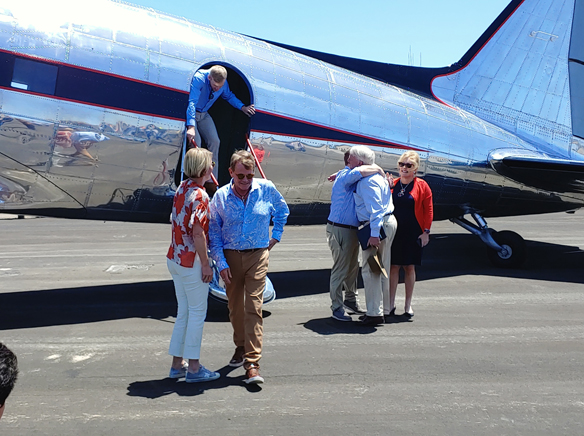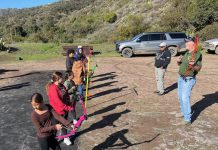
It some ways, as Philip Wrigley’s original 1940s era silver and blue DC-3 propeller airliner made a breathtaking fly-over of the island and ACE Clearwater Field, it looked much like it did as Wrigley landed here in his heyday.
Moreover, the return of Wrigley’s airplane played silent tribute to Philip Knight Wrigley’s legacy in aviation, as it turns out, he pioneered airplanes, routes and even helped design a groundbreaking seaport nearly two decades before the “Airport in the Sky” was even in thought.
Although considered “modest” by the promotional standards of his father, William Wrigley, Jr., P.K., or Phil (he reportedly preferred Phil), as some called him, never shunned the spotlight. In his late 30s when he finally took over his dad’s company, including the interests of Catalina Island, Philip Wrigley brought much innovation and energy to the challenge.
So, it is fitting that his granddaughter, Alison was the first to step off the plane onto the airport’s newly renovated runway and tarmac. “It reminded me of growing up,” she said exiting the plane, when as a little girl, the family would sometimes get an opportunity to ride on her grandfather’s plane.
This too is a reminder that although much of what we understand as history in black and white was to them, vivid and in living color. Apparently, Phil knew from his earliest days, as did his father, that transportation routes were critical to their resort island’s future success.
After all, Philip Wrigley had served in the U.S. Navy during WWI, rising to the rank of Lieutenant to head the Great Lakes Naval Training Station, supervising the aviation mechanics.
Phil loved the Navy and their flying machines so much that during WWII, he reportedly refused to install lights at Wrigley Field in Chicago and instead, donated the money to the U.S. Navy.
According to a insightful book “Catalina by Air” by Jeannine L. Pederson, Charlie Chaplin’s half-brother Syd was the first to offer air service to Catalina in 1919, operating a small seaplane service that lasted two years.
The route was later operated by Pacific Marine Airways, which was in turn acquired by Western Air Express in 1928.
Phil Wrigley, apparently always the aviation enthusiast, decided not to renew the Western’s air contract. Wrigley decided it was time for Catalina to have its own airline, founding the Wilmington Catalina Airline, which took over the route.
Catalina’s airline used the seaplanes and operated from a unique “turn-table” strip at Hamilton Cove to Wilmington. Philip Wrigley reportedly developed or dictated much of the innovative technology for the “turn-table” aspect of the airline.
Later, Wrigley refined the “flying boats” even further, working alongside two future titans of the aircraft industry, Donald Douglas (Douglas Aircraft) and William “Bill” Boeing (Boeing).
The Douglas Dolphin twin-engine seaplane was the first of his planes to be used as a commercial passenger airliner, pre-dating the DC-1, comfortably seating 10 passengers for a one-way fare of $5 (the “Dolphin” was reportedly so luxurious that Boeing even bought a Douglas Dolphin for his own use).
Nevertheless, the airline operated successfully for a decade, reportedly without a single incident.
With the constant improvement of aerodynamics, engines and other aircraft technology, the airline industry exploded across the country. One of the aircraft developed by his friend, Donald Douglas (DC-3) began a workhorse of American aviation, offering to get passengers from New York to California in 13-15 hours). For that day, it was revolutionary.
The need for more land-based aviation service became evident in 1940 and Wrigley settled on the current location for an airport as the two mountains were leveled and the canyon filled in.
Then on Dec. 7, 1941, with the airport nearly complete, the Japanese bombed Pearl Harbor and the future of the airport, and the island, was in doubt as Catalina became, besides Hawaii, one of the westernmost lookouts to the Pacific.
In the autumn of 1942, the United States Army Air Forces (USAAF) took control of the (then called) Buffalo Springs Airport for the duration of World War II, to support Army, Navy, Coast Guard, the Maritime Service, and the Office of Strategic Services (OSS) activities on the island.
The airfield was leased to the U.S. government at $1 per year during the entirety of the war years.
After the war, the airport finally and officially opened in 1946. The Catalina Island Conservancy took over its operation in 1972, when the Conservancy was formed. The Conservancy, also founded by Philip K. Wrigley, operates the Airport in the Sky as a public airport.
This brings us back to the DC-3 on which Alison, her husband and the runway project’s major donors, Kellie and Gary Johnson, travelled to the Airport in the Sky last week. So much had happened before and after the purchase of this flying machine that was so emblematic of Catalina’s aviation history.
At the time when Philip K. Wrigley originally purchased the plane in 1947, the DC-3 was expanding its role as a workhorse of the growing airline industry and the U.S. military.
Although by today’s standards the 3,200-foot runway does not accommodate most jets, it was plenty sufficient for the twin-propeller craft in the 1940s.
Let’s face it, jet’s may have been envisioned back then, but they were plenty excited to have these luxurious DC-3 planes that could easily land within 3,000 feet.
In fact, United Airlines, one of today’s leading air carriers offered paid passenger service from the mainland to Catalina from 1946 until 1954.
The Wrigley family eventually sold the plane and only recently was the family able to track it down and repurchase it. Alison said last week the family was fortunate to have been able to re-locate the DC-3 and said it is undergoing a complete restoration.
According to the Airline Owners and Pilots Magazine, the Wrigley DC-3 had been built in 1944 as a Douglas C–47 Skytrain (military aircraft) that had been converted to a DC3 in 1947 and purchased by Philip and Helen Wrigley and was operated out of Catalina.
With only 3,434 hours in its logbook, this apparently is the lowest-time DC–3 in the world. The airplane is currently in the process of undergoing a complete restoration by Aerometal International in Aurora, Oregon, according to AOPA.
Pilot Paul Bazeley said the bird flew perfectly as they flew it from Santa Barbara, over Avalon and into Airport in the Sky.
Since opening to the public, Catalina’s Airport in the Sky has become a favorite destination for pilots, who land and take off from the airport about 14,000 times annually.
The Airport in the Sky is a historical and critical asset that provides access to Catalina Island via air for first responders, travelers, residents and businesses.
The airport is the Island’s U.S. Mail and UPS delivery hub. An estimated 3.5 million pounds of freight, which includes medical and emergency supplies, is also shipped through the airport annually.
Over the years, the airport’s famed in-house restaurant, the DC-3 grill, began to serve its famous cookies and captured the public imagination by serving “buffalo burgers,” named after island’s famous bison.
Movie icon Cary Grant was reportedly one of many stars who would fly-in or stop by the Airport in the Sky simply to pick up a buffalo burger as the tiny Catalina airport developed a fan club of its own.
Now with the help of the U.S. Marines, U.S. Navy Seabees and, according to current Conservancy President and CEO Tony Budrovich, much incredible innovation from today’s island contractors, the Airport in the Sky’s Ace Clearwater field has a brand-new runway for the next phase of Catalina’s ongoing aviation tradition.
So while it looks now like the sky’s the limit for the Airport in the Sky, it is also a great time to remember those who built runways to the future many years ago.
Email your stories about your experiences at the Airport in the Sky to editor@thecatalinaislander.com.










